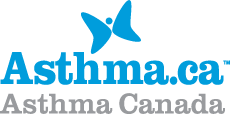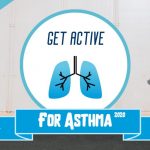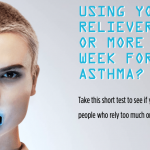The 2020-2021 back to school season will be difficult for both students and teachers living with asthma. As schools reopen during COVID-19, there will be new aspects of asthma management to consider. Safety measures including, masks, physical distancing, and increased cleaning will all impact the way schools operate and how we keep our community safe.
Asthma is a serious chronic condition that affects more than 3.8 million Canadians, including over 850,000 children under the age of 14. For Canadian children, asthma is the most common long-term respiratory disease and accounts for more hospitalizations than any other chronic illness. With the current COVID-19 pandemic, asthma safety in schools is more important than ever.
Asthma Canada has gathered recommendations to help our community prepare for the back to school season and September Asthma Peak to protect those living with asthma. These recommendations are not meant to replace government guidelines (visit PHAC for the latest guidelines & COVID-19 updates) but to act as a companion piece with a specific focus on the Canadian asthma community. As new information becomes available the information provided here may change or be amended based on the latest research.
September Asthma Peak
Canadian researchers have found that the September back-to-school period brings a dramatic increase in hospitalizations for children with asthma. This increase starts after the return to school and reaches its peak in September. This period is now recognized as the September Asthma Peak. Being ready for the September Asthma Peak is one way to help ensure that your child will stay healthy and avoid spending time in the emergency room of a hospital.
Kids returning to school in September face increased exposure to viral infections. These can be a significant trigger of asthma symptoms. Children may also be exposed to allergens such as dust mites, moulds and animal dander. September is also the ragweed season. All these allergens are potent asthma triggers. This is why it is so important that your child’s asthma be properly controlled year-round.
Preparing for September Peak
Below we have outlined some tips for all parents of children with asthma to follow. These steps will help improve your child’s asthma control and ensure they are as prepared as possible for the return to school. These suggestions are especially important during this back to school season and keeping students safe during COVID-19.
- Develop or update a written Asthma Action Plan with your family doctor or healthcare provider and make sure to share a copy with your child’s school and teacher. If your child doesn’t currently have an Asthma Action Plan, make an appointment with their healthcare provider to create one as soon as possible.
- Speak with your child’s school about their asthma policies including inhaler use and ensure it has policies in place to create a trigger-free environment for learning, exercise and play. Always ensure that your child has their reliever (rescue) medication on hand at all times. In the province of Ontario, Ryan’s Law states: “Every school principal shall permit a pupil to carry his or her asthma medication if the pupil has his or her parent’s or guardian’s permission.” Read more about Ryan’s Law.
- Ensure that your child takes their asthma controller medication throughout the year, even when symptom-free. Make sure you child is taking their asthma medications as prescribed and don’t stop unless advised by their healthcare provider to do so.
- Schedule regular asthma check-ups with your healthcare provider to ensure your child’s asthma is properly controlled. It’s especially important to have a checkup right before back to school season. Ensure your healthcare provider reviews your child’s inhaler technique.
- Make sure you refill or renew your child’s asthma medication prescription. We recommend having a 30-day supply of medication on hand.
- Identify your child’s asthma triggers and teach them how best to avoid them.
- Teach your child what to do in case of an asthma attack.
- Help your child understand their asthma, including teaching them how to use their medications properly. Review their inhaler technique. Make sure they know how to use their Asthma Action Plan.
- Teach your child correct hand washing technique and the importance of frequent hand washing.
- If your children are sick or exhibiting any symptoms of COVID-19, keep them home from school and speak with your healthcare provider.
- Teach your children ways to cope with stress and anxiety as strong emotions and anxiety can trigger an asthma attack.
- Ensure your child, and everyone in your home, has received their influenza (flu) and pneumococcal disease vaccinations.
Additional Considerations
Masks
Make sure your child knows how to wear their mask or face covering properly. It should cover both the nose and mouth. If the mask gets soiled or wet, be sure to wash and dry it before wearing again. It may be a good idea to pack more than one mask, so they have a spare easily accessible during the school day. You can read information about appropriate use of non-medical masks, and how to properly place, remove and clean a non-medical mask from the Public Health Agency of Canada. Be sure to check your provincial or territorial authority for up-to-date guidance.
Wearing a face mask is NOT a substitute for physical distancing or frequent handwashing. Wearing a non-medical face mask or face covering is measure that protects those around you. When worn properly, a person wearing a non-medical mask or face covering can reduce the spread of their own infectious respiratory droplets.
The vast majority of people with asthma can wear a non-medical mask or face covering safely and are recommended to do so. If your child is unable to wear a non-medical mask without experiencing breathing issues, it is important that you contact your healthcare provider as soon as possible to review their asthma control.
Tips for Wearing Masks:
- Experiment with different types of mask materials and styles. Some masks fit more snugly than others, and some materials may feel more comfortable or be more breathable. Always refer to proper mask wearing.
- Do not share masks or face coverings.
- Help your children adjust to wearing a mask: have them wear it around the house for 20 minutes to give them time to adjust to how it feels.
- There is no recommended “best mask” for people with asthma. You should experiment to find the mask material that works best for your child: cloth masks, bandanas and scarfs may all be options.
- Pack a spare mask in case your child’s mask becomes soiled or wet during the day.
Cleaning Supplies
With increased cleaning and disinfecting protocols in place, staff and students are likely to have greater exposure to scented cleaning supplies and chemicals which can be serious asthma triggers. Those with asthma should avoid rooms or areas where cleaners are being used and for a period of time after their use to let the scents/chemicals dissipate. If possible, the use of scent-free cleaners, hand sanitizers and chemicals are recommended. After strong cleaning products are used, windows can be opened to air out the room, unless outdoor air quality or pollen counts poses a risk to students with asthma.
You can check your local Air Quality Health Index here: https://www.canada.ca/en/environment-climate-change/services/air-quality-health-index.html
Air Quality
Most of the time spent at school is spent indoors, making indoor air quality extremely important. Common airborne asthma triggers include allergens, scented products (i.e. perfumes, cleaning supplies, scented laundry products etc.), dust mites, moulds and chemicals. Minimizing asthma triggers and improving indoor quality is an important step toward preventing asthma attacks.
Asthma Canada recommends using scent-free cleaning products and employing a scent-free policy within schools. Frequent cleaning can cut down on dust mites and any leaks should be fixed to prevent mould. Allergic asthma triggers like pets and animals should be kept out of classrooms. When opening windows, outdoor air quality should always be considered first. Checking the Air Quality Health Index can help prevent outdoor triggers like pollen and smoke from getting into the classroom. When planning outdoors activities teachers and school officials should take outdoor air quality into account and consider indoor recess or activities on days with poor air outdoor air quality.
Is your child’s asthma controlled?
Proper asthma control is key to staying healthy with asthma and preventing possibly life-threatening asthma attacks. Everyone with asthma should be able to achieve good asthma control. If your child is having trouble staying symptom-free or have any of the signs of poor asthma control listed below, we highly recommend speaking with your healthcare provider as soon as possible.
Signs of Poor Asthma Control:
- Frequent breathing difficulties, including coughing or wheezing most days
- Asthma impacting sleep; if asthma wakes your child up at night, their asthma isn’t controlled
- Inability to exercise without experiencing breathing difficulties
- Relying on the reliever (rescue) inhaler more than 3 times per week
- Severe breathing difficulty or inability to wear a mask or face covering
- Recent asthma attack or hospitalization
What to do if your child’s asthma is poorly controlled
If your child’s asthma is poorly controlled you need to speak with your healthcare provider. Uncontrolled asthma is very serious and could lead to a life-threatening asthma attack. It’s vital that you take your child’s asthma seriously and recognize when symptoms aren’t properly controlled. Over time, poorly controlled asthma can cause permanent damage to your airways that cannot be reversed. This is called ‘airway remodeling’. It is important to have proper treatment for your asthma to avoid this permanent damage.
If your child’s asthma is not well controlled, talk to their healthcare provider about their symptoms. You can help your child gain control of their asthma by:
- Making sure they follow a treatment plan. Taking a controller medication as prescribed minimizes asthma symptoms long-term and reduces underlying airway inflammation.
- Working with your healthcare provider to create an Asthma Action Plan, and having your child follow it.
- Avoiding asthma triggers as much as possible.
- Discussing your child’s asthma with your healthcare provider on a regular basis so that your child’s asthma never becomes uncontrolled and their medications can be adjusted if necessary. Ask your child’s healthcare provider to review their inhaler technique.
COVID-19 & Asthma
You can learn more about Asthma Canada’s recommendations for COVID-19 and asthma here.
Did you find this content useful?
The Asthma Canada team, including our Certified Respiratory Educators are working tirelessly to provide the most up to date education and support regarding Coronavirus (COVID-19) to the asthma community.
Canadians with asthma are depending on us now more than ever. We are only able to do the work that we do thanks to the generosity of people like you. If you are able to, please consider a donation to support our mission during this time. Thank you!






